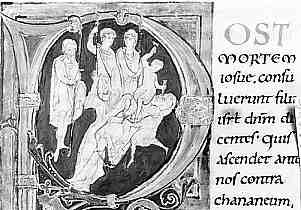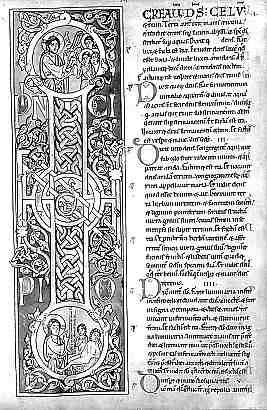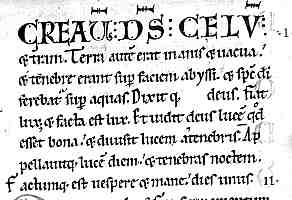



If you are looking at this page without frames, there is more information about medieval writing to be found by going to the home page (framed) or the site map (no frames).
| Great Big Bibles | ||||
| The Codex Amiatinus, as mentioned in the section on Early Bibles and Gospels, represents the beginning of a new phase of Bible making, when complete Bibles containing all the books of the Old and New Testaments were produced in large formats. They could be in several volumes, and made their appearance from around the 11th century and into the 12th. They appeared in the major monasteries during the period of reform of Gregory VII and many were donated to the monasteries by ecclesiastical patrons. | ||||
| More details on large format Bibles can be found in de Hamel 1984 and de Hamel 2001. | ||||
 |
The corner of a page, with historiated initial, from a large bible produced for the Abbey of St Remacle, Stavelot, Belgium between 1094 and 1097 (British Library, add ms 28106, f.84). By permission of the British Library. | |||
| These works were not only large in format, but handsomely produced with the decorative elements of historiated initials and fancy borders. The above example displays a historiated initial from the beginning of the book of Judges, depicting Jael, the wife of Heber the Kenite, killing Sisera, captain of the army of Jabin the king of Hazor, by driving a tent peg through his temple while he was exhausted from battle. A nasty piece of work really. | ||||
 |
Because the volumes were huge and handsome, it has sometimes been suggested that these were display works, designed to look imposing on the lectern during the reading of the liturgy. De Hamel (De Hamel 2001) has a much more logical suggestion; that they were exemplars designed to provide accurate texts for the production of the various service books for use in the church. Among other reasons, he points out that the books were huge because of their massive content, but the script was not necessarily large or easy to read in a dimly lit church. | |||
| The first page of Genesis from a two volume Bible of 1148 from Germany (British Library Harley 2803, f.6v), by permission of the British Library. | ||||
| The first paragraph of text from the above example. |
 |
|||
| The neat protogothic script of this example is not of the huge and bold type that old paleographers called "a fine liturgical hand" as used in service books. It is tidy, but laterally compressed and heavily abbreviated. | ||||
| The size of the volumes and the elaborate decorative elements may have emphasised the prestige aspect of these volumes, but that did not require them to be on public display. There was much in the way of artistic expression that remained within the monasteries for the glory of God and the aesthetic delight of the monks themselves. St Bernard of Clairvaux had a few things to say on that subject, but that is another story altogether. | ||||
| The graphic elements also provide place markers and guides to reading the text. The historiated initial P in the first example and the huge I in the second one contain scenes from the following text. Such visual cues not only helped in locating particular passages, but in remembering them. Even with the service books in front of them, the daily performance of the liturgy required prodigious feats of verbal memory. | ||||
 |
Historiated initial in a late 12th century large three volume Bible (Paris, Bibliothèque St Geneviève, MS 8 - 10, vol ii, f. 238b). (From New Palaeographical Society 1907) | |||
| The historiated initial of King Solomon appears at the beginning of the book of Proverbs, providing an obvious graphic reference for the reader, or copyist. | ||||
| It is highly likely that a greater proportion of these large exemplars have survived than of the multiple copies of various segments made for liturgical reading. After all, as exemplars they would have been carefully curated while the working service books were in daily use, subjected to greasy fingers, candle smoke and flattening out the pages for reading. The very thought would make a librarian faint! | ||||
|
|
||||
|
|
||||
|
If you are looking at this page without frames, there is more information about medieval writing to be found by going to the home page (framed) or the site map (no frames). |
||||